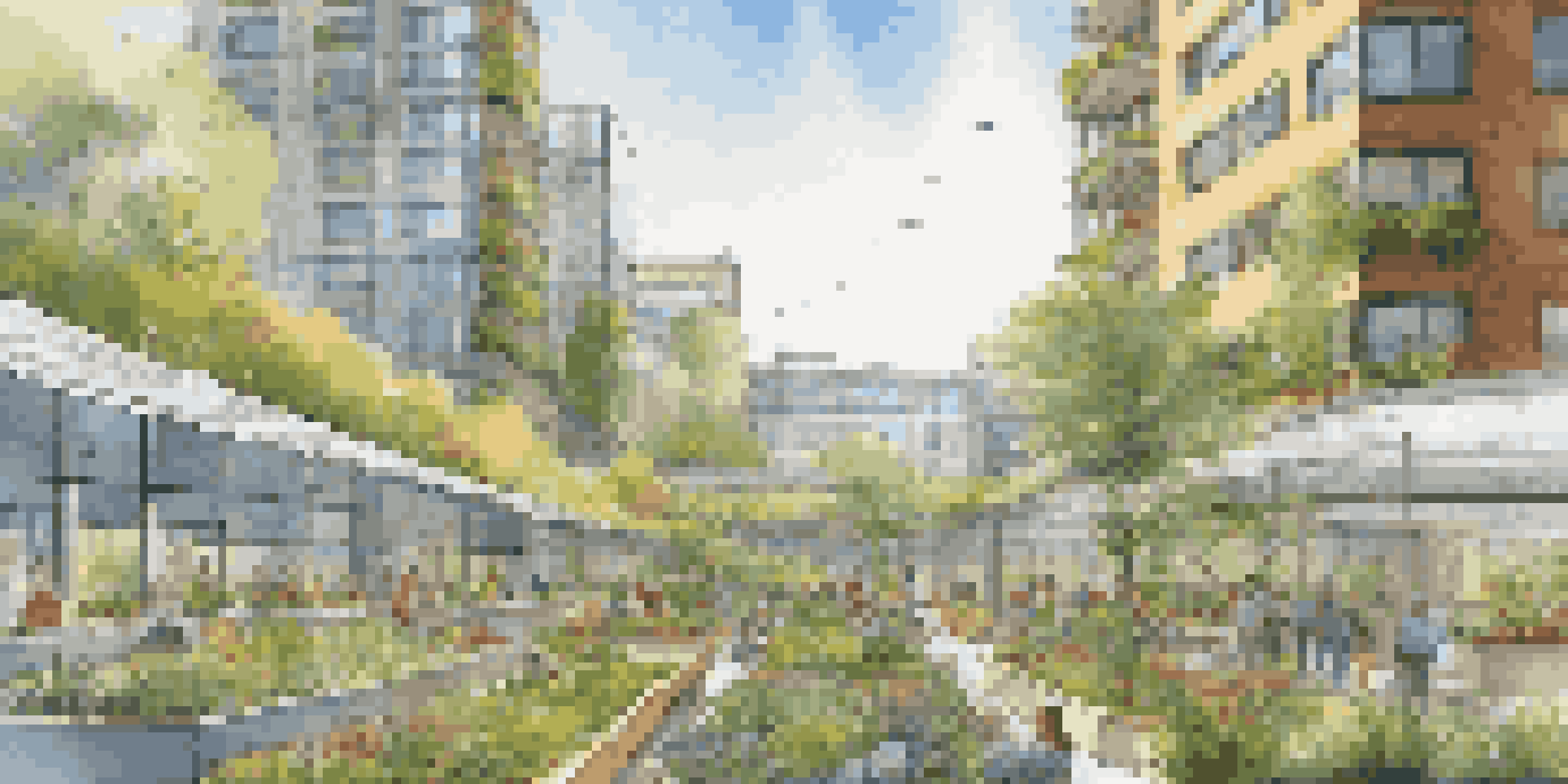Sustainable Urban Development: Technologies Shaping Cities

Understanding Sustainable Urban Development and Its Importance
Sustainable urban development focuses on creating cities that meet current needs without compromising future generations. It emphasizes balancing social, economic, and environmental factors to foster a vibrant urban life. As more people move to cities, prioritizing sustainability becomes crucial for resource management and quality of life.
Sustainability is no longer about doing less harm. It's about doing more good.
Cities consume over two-thirds of the world's energy and account for a significant portion of greenhouse gas emissions. Therefore, adopting sustainable practices can significantly mitigate climate change impacts. This approach also enhances urban resilience against environmental challenges, making city life more adaptable and enjoyable.
Incorporating sustainability into urban planning is not just an environmental necessity; it is also an economic opportunity. By investing in green technologies and infrastructures, cities can create jobs, stimulate innovation, and improve community well-being. Ultimately, sustainable urban development contributes to a healthier planet and a better quality of life for all.
Smart Grids: Revolutionizing Energy Management in Cities
Smart grids utilize digital technology to enhance electricity distribution and consumption. By integrating renewable energy sources and improving efficiency, they play a vital role in reducing urban carbon footprints. Imagine a grid that intelligently manages energy flow based on real-time usage and demand, leading to lower costs and reduced waste.

These advanced systems allow cities to incorporate solar panels, wind turbines, and energy storage solutions effectively. For instance, during peak hours, excess energy generated by renewables can be stored and utilized later, providing a more stable and reliable power supply. This flexibility not only enhances energy independence but also promotes greener energy usage.
Cities Need Sustainable Development
Sustainable urban development balances social, economic, and environmental factors to enhance city life and resource management.
Moreover, smart grids empower consumers to monitor their energy consumption via mobile apps, encouraging more mindful usage habits. As residents become more aware of their energy impacts, they can actively participate in reducing demand during peak times. Overall, smart grids represent a significant step toward sustainable urban energy management.
Green Architecture: Designing Eco-Friendly Buildings
Green architecture focuses on constructing buildings that minimize environmental impact through sustainable materials and energy-efficient designs. This approach not only reduces resource consumption during construction but also promotes healthier living spaces for occupants. Think of buildings that breathe with natural ventilation and utilize sunlight to reduce heating costs.
The greatest threat to our planet is the belief that someone else will save it.
For example, passive solar design harnesses sunlight for natural heating, which can significantly lower energy bills. Incorporating green roofs and walls further enhances insulation and reduces urban heat islands, contributing to cooler cities. These strategies lead to aesthetically pleasing structures that harmonize with their surroundings.
Additionally, green buildings often feature water-efficient systems, such as rainwater harvesting and greywater recycling. By using these technologies, cities can alleviate pressure on local water supplies while promoting sustainable practices among residents. Ultimately, green architecture shapes urban spaces into healthier, more sustainable environments.
Public Transportation Innovations for Sustainable Mobility
Public transportation systems are crucial for reducing traffic congestion and lowering emissions in urban areas. By investing in innovative solutions, cities can encourage more people to opt for public transit over private vehicles. Imagine a city where electric buses and trams run on time, providing seamless connections throughout the urban landscape.
Technologies such as real-time tracking and mobile ticketing apps enhance the user experience, making public transit more convenient and accessible. For instance, commuters can receive notifications about delays or changes in schedules, allowing for better planning of their journeys. This ease of use can significantly increase ridership and decrease reliance on personal cars.
Smart Tech Transforms Urban Living
Technologies like smart grids and IoT enhance energy efficiency and urban management, paving the way for greener cities.
Moreover, integrating various modes of transport, like bike-sharing programs and electric scooters, creates a comprehensive mobility network. By providing diverse options for transportation, cities can cater to different preferences and needs, ultimately fostering a more sustainable urban lifestyle. Public transit innovations are key to shaping cities that prioritize both mobility and environmental responsibility.
Smart Waste Management: Reducing Urban Waste Footprint
Smart waste management systems leverage technology to optimize waste collection and recycling processes in cities. By using sensors in waste bins, municipalities can monitor fill levels and schedule pickups more efficiently. This proactive approach reduces unnecessary collections, saving time and resources while also minimizing vehicle emissions.
Additionally, data analytics can help cities identify patterns in waste generation, allowing for targeted recycling programs. For example, if a neighborhood consistently generates large amounts of organic waste, tailored composting initiatives can be introduced to divert that waste from landfills. This not only promotes sustainability but also educates residents on responsible waste practices.
Moreover, public awareness campaigns can be enhanced through mobile applications that provide information on recycling guidelines and local waste facilities. By engaging the community in waste management efforts, cities can foster a sense of shared responsibility. Smart waste management technologies are transforming how urban areas handle waste, paving the way for cleaner and greener cities.
Urban Agriculture: Integrating Green Spaces into City Life
Urban agriculture involves cultivating, processing, and distributing food within urban environments. This practice not only brings fresh produce closer to consumers but also contributes to greener cities by enhancing biodiversity and reducing carbon footprints. Picture rooftop gardens and vertical farms sprouting amidst skyscrapers, turning concrete jungles into vibrant food hubs.
Community gardens and urban farms also promote local food production, fostering connections among residents and providing educational opportunities. They encourage healthy eating habits while addressing food insecurity in urban areas. By involving the community in growing their food, cities can empower citizens and enhance social cohesion.
Community Engagement is Essential
Fostering community involvement in sustainability initiatives creates a culture of responsibility and enhances urban resilience.
Furthermore, urban agriculture can improve air quality and reduce stormwater runoff through strategic landscaping. By incorporating green spaces, cities can mitigate the effects of urban heat islands and provide residents with recreational areas. Ultimately, urban agriculture not only enriches city life but also supports sustainable living practices.
IoT and Big Data: Enhancing Urban Living Through Technology
The Internet of Things (IoT) and big data are transforming how cities operate by collecting and analyzing vast amounts of information. Sensors placed throughout urban areas can monitor traffic patterns, air quality, and energy usage, providing valuable insights for city planners. For example, real-time data can help optimize traffic signals, reducing congestion and emissions.
In addition, big data analytics can inform decisions on resource allocation and infrastructure improvements. By identifying trends and patterns in citizen behavior, city officials can implement targeted solutions that enhance urban living. This data-driven approach allows for more efficient use of resources and better alignment with community needs.

Moreover, engaging residents in data collection through mobile apps can foster a sense of ownership and responsibility. Citizens can report issues like potholes or waste overflow, facilitating quicker responses from city services. Ultimately, harnessing IoT and big data empowers cities to become more responsive, efficient, and sustainable.
Conclusion: Building Sustainable Cities for Future Generations
As urban populations continue to grow, the need for sustainable development becomes increasingly urgent. By adopting innovative technologies, cities can create environments that balance ecological needs with human demands. The integration of smart grids, green architecture, public transportation, waste management, urban agriculture, and data analytics lays a solid foundation for future urban living.
Sustainable urban development is not just about technology; it’s also about fostering community engagement and awareness. Encouraging residents to participate in these initiatives cultivates a culture of sustainability that extends beyond individual actions. Together, we can build cities that prioritize well-being, resilience, and environmental stewardship.
Ultimately, embracing these technologies and practices will lead to thriving urban spaces where people can live harmoniously with nature. By prioritizing sustainability today, we are investing in a healthier, more equitable, and prosperous future for generations to come.